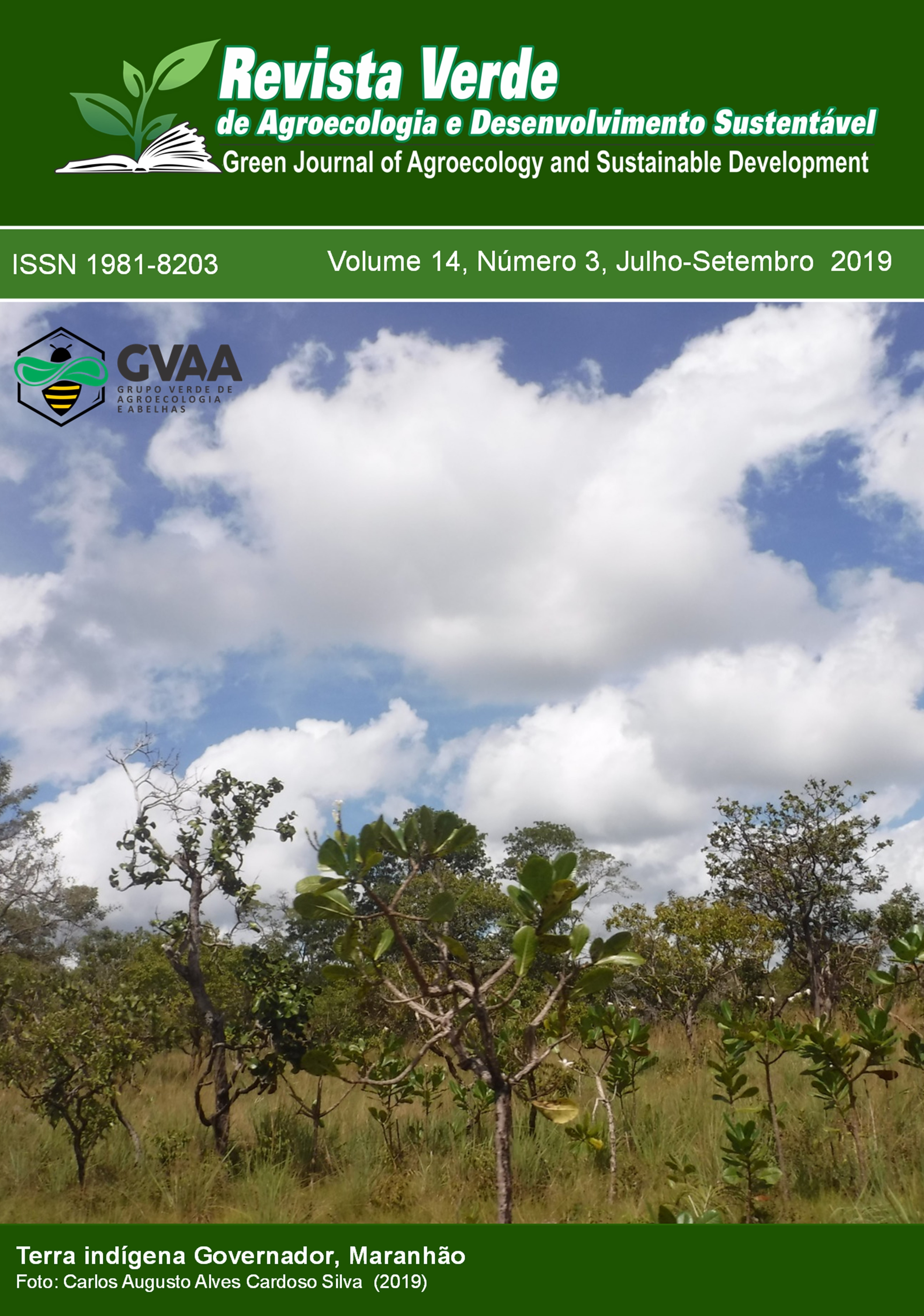Allelopathic effect of Libidibia ferrea Mart. on the vigor of cowpea seeds
DOI:
https://doi.org/10.18378/rvads.v14i3.5974Keywords:
Agroforestry, Vigna unguiculata, CaatingaAbstract
The cowpea is one of the main crops of importance for the Northeast region, being cultivated in areas of the Caatinga, considering that it is necessary to study the interaction between agricultural crops and forest species in this biome. Therefore, the present study aimed to evaluate a possible allelopathic influence of dried leaves in the decomposition process of Libidibia ferrea Mart. on the development of caupi bean seedlings, cv. Canapu. The leaves of the forest species were collected in the morning and dried at 40 ºC for 24 hours in the greenhouse, then were manually fragmented and added to sand forming the substrate, the following proportions of dry leaves and sand were adopted: 1:0 (control); 1:1/2; 1:1 and 1:2 (v:v). The substrates were decomposed for 15, 30, 45 and 60 days, the control treatment without decomposition, so subsequently the seeds of cowpea were sown. The seedling height and root length, dry mass of the aerial part of the root system and total normal seedlings were evaluated. The entirely randomized 4x5 factor scheme was used (sand proportions: dry leaves x periods of decomposition). The period of 30 days of decomposition causes a reduction in the length of the aerial part, in the dry mass of the aerial part, in the root system and in the total of the seedlings, the increase in the proportions of dry ironwood leaves affects the dry mass of the aerial part and total of the seedlings. Therefore, the cultivation of caupi beans, cv. Canapu, and ironwood in an agroforestry system is not feasible.Downloads
References
CHOU, C. Roles of allelopathy in plant biodiversity and sustainable agriculture. Critical Reviews in Plant Sciences, v.18, n.5, p.609-636. 1999.
CRUZ, S. E. M.; NOZAKI, M. H.; BATISTA, M. A. Plantas medicinais. Biotecnologia Ciência e Desenvolvimento, Brasília, n. 15, p. 28-34, 2000.
FERREIRA, A. G.; BORGHETTI, F. Germinação do básico ao aplicado. 2. ed. Porto Alegre: Artmed, 2004. 323 p.
FERREIRA, D. F. Sisvar: a computer statistical analysis system. Ciência e Agrotecnologia. v.35, n.6, p.1039-1042, 2011.
JANDOVÁ K.; DOSTÁL, P.; CAJTHAML, T. Searching for Heracleum mantegazzianum allelopathy in vitro and in a garden experiment. Biological Invasions, v. 17, n. 4, p. 987-1003, 2015. 10.1007/s10530-014-0771-5.
LEWIS, G. P. Libidibia in Lista de Espécies da Flora do Brasil. Jardim Botânico do Rio de Janeiro. Disponível em: <http://floradobrasil.jbrj.gov.br/jabot/floradobrasil/FB109843>. Acesso em: 10 set. 2018.
LORENZI, H. Árvores Brasileiras: manual de identificação e cultivo de plantas arbóreas nativas do Brasil. Nova Odessa: Plantarum, 2008a. p.126, 384p.
LORENZI, H.; MATOS, F.J.A. Plantas medicinais do Brasil: nativas e exóticas. 2.ed. Nova Odessa, SP: Instituto Plantarum, 2008b. 544p.
MALHEIROS, R. S. P.; SANTANA, F. S.; LINHARES NETO, M. V. L.; MACHADO, L. L.; MAPELI, A. M. Atividade alelopática de extratos de Lafoensia pacari A. ST. –HIL. sobre Lactuca sativa L. e Zea mays L. em condições de laboratório. Revista Brasileira de Agroecologia, v. 9, n. 1, p. 185-194, 2014.
MATOS FILHO, C. H. A.; GOMES, R. L. F.; ROCHA, M.; M.; FREIRE FILHO, F. R.; LOPES, Â. C. A. Potencial produtivo de progênies de feijão-caupi com arquitetura ereta de planta. Ciência Rural, v.39, n.2, p.348-354, 2009.
MINISTÉRIO DO MEIO AMBIENTE (MMA). Biomas Brasileiros Disponível em: <http://www.mma.gov.br/biomas/caatinga> Acesso em: 06 de jan. 2018.
NAKAGAWA, J. Testes de vigor baseados no desempenho de plântulas. In: KRZYZANOWSKI, F.C.; VIEIRA, R.D.; FRANÇA NETO, J.B. (Eds). Vigor de sementes: conceitos e testes. Londrina: ABRATES, p. 1-21. 1999.
NEGI, A.; BATISH, D. R.; SINGH, H. P.; KOHLI, R. K. Allelopathic Effect of Leaves of Invasive tree Broussonetia papyrifera against some crop plants. Annals of Plant Sciences, v. 5, n. 1, p. 1261-1264, 2016. 10.21746/aps.2016.01.003
OLIVEIRA. A, K.; COELHO, M. F. B.; MAIA, S. S. S.; DIÓGENES, F. E. P. Atividade alelopática de extratos de diferentes orgãos de Caesalpinia ferrea na germinação de alface. Ciência Rural, v.42, n.8, p.1397-1403, 2012.
SANTOS, J. A. S.; TEODORO, P. E.; CORREA, A. M.; SOARES, C. M. G.; RIBEIRO, L. P.; ABREU, H. K. A. Desempenho agronômico e divergência genética entre genótipos de feijão-caupi cultivados no ecótono Cerrado/Pantanal. Bragantia, v. 73, n. 4, p. 377-382, 2014. 10.1590/1678-4499.0250
SILVA, J. N., PINTO, M. A. D. S. C. Ação alelopática de folhas secas de umbu, em processo de decomposição, sobre o potencial fisiológico de sementes de feijão caupi. Agrarian Academy, Centro Científico Conhecer - v.4, n.8; 2017.
SOUZA, B. I. F.; ARTIGAS, R. C.; LIMA, E. R. V.; Caatinga e desertificação. Mercator, v.14, n.1, p.131-150, 2015.
VIEIRA, C. L.; FREITAS, A. D.; SILVA, A. F.; SAMPAIO, E. V.; ARAUJO, M. do S. Inoculação de variedades locais de feijão macassar com estirpes selecionados de rizóbio. Revista Brasileira de Engenharia Agrícola e Ambiental, v. 14, n. 11, p. 1170-1175, 2010.
ZHENG, Z.; SHANMUGHAVEL, P., MIN CAO, L. S.; WARREN, M. Litter decomposition and nutrient release in Tropical Seasonal Rain Forest of Xishuangbanna, Southwest China. Biotropica, v. 38, n. 3, p. 342-347, 2006.











